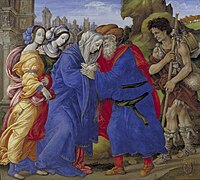Joachim and Anne Meeting at the Golden Gate
Joachim and Anne Meeting at the Golden Gate is a narrative of the parents of the
Story
Benedict Chelidonius' work describes the story of the married couple Joachim and Anne, who, though they are devoted to each other, are deeply unhappy as they are childless, which they take as a sign that they must have been rejected by God. An angel informs Anne that she will conceive, while at the same time asking her to meet her husband at the city gate in Jerusalem. On meeting, the couple entwine in joy. According to Chelidonius: "Overjoyed Anne threw herself into the arms of her husband; together they rejoiced about the honour that was to be granted them in the form of a child. For they knew from the heavenly messenger that the child would be a Queen, powerful on heaven and on earth".[1] In traditional depictions of the occasion, the pair embrace, but don't kiss.[2]
Theological implications
This scene represented the
The 14th and 15th centuries were the heyday of depictions. In a 1410 French Mass book, Anne and Joachim are depicted in front of a castlelike structure representing the Golden Gate. The image precedes the Mass for the Feast of the Conception of the Virgin Mary.[4] Gradually more allegorical depictions of the Immaculate Conception, featuring an adult Mary, replace this scene in representing the doctrine.[5]
The church had developed the doctrine that the Virgin Mary was, uniquely, conceived without
-
Russian icon, perhaps before 1169
-
Master of the Golden Gate, late 14th century
-
Louis IXand Saint Liberata.
-
Filippino Lippi, 1497
-
Eugenio Cajés, 1605; by now the scene was becoming less frequent
References
Sources
- Hall, James, Hall's Dictionary of Subjects and Symbols in Art, 1996 (2nd edn.), John Murray, ISBN 0719541476
- Kurth, Dr. Willi. The complete woodcuts of Albrecht Durer. New York: Arden Book Co, 1935.
- Nurnberg, Verlag Hans Carl. Dürer in Dublin: Engravings and woodcuts of Albrecht Dürer. Chester Beatty Libraery, 1983.
- Strauss, Walter L. "Albrecht Durer Woodcuts and Woodblocks". The Burlington Magazine, Vol. 124, No. 955, October, 1982. pp. 638–639.






